|
Welcome to the Spring edition of the Marche Voyager newsletter. Sadly, the Marche region has not been spared from the effects of the coronavirus. As of today, Friday 3 April, 4,230 people have been infected here, with 557 deaths so far, 322 in the worst-hit province of Pesaro and Urbino.
However, the brighter news is that the rate of infection has been dropping for the past few days and the peak looms on the near horizon. In the summer issue of the newsletter we hope to be able to give you concrete news about when and how visiting the region will again be possible.
In the meantime, we thought we’d offer you some pieces from our past 60 issues of the newsletter to brighten up your lockdown – buona lettura wherever you are!

the view from the Marche Voyager office
Wild thing! (Spring 2005)
The days are at last warming up after one of the snowiest winters on record in the Marche - the snow reached a depth of over one and a half metres in many inland areas and took up to a month to melt.
As the trees break into leaf people with over-stuffed carrier bags wander across fallow fields, carefully inspecting the ground as they go, gathering the many wild herbs - herbe del campo - that still play a part in the marchigiana diet.
Weeds such as the common dandelion, field poppy and the more tender types of thistle are carefully cut at their roots to be eaten either raw in salads as a misticanza, or boiled before being quickly sautéed in good olive oil with a clove of garlic and a squeeze of lemon juice at the end.
Another of these wild plants is Silene vulgaris, the common weed bladder campion. In the Marche it is variously known as striti, stridi, or stringoli and the young shoots are lightly cooked to be then used in a frittata, or fried with a little onion and some ham for dressing pasta.
The hedgerows also have treasures; one of the most common climbers across Europe is wild clematis or old man's beard, Clematis vitalba. Here in the Marche it's known simply as vitalba and the young growing tips - roughly the first 10cms with the tip still a closed bud - are enthusiastically picked in spring. They are then blanched in boiling water for a few minutes to get rid of the excess bitterness before being added to a frittata, or Italian-style omelette. The Italian frittata, unlike its French cousin, should be cooked very slowly until fully set and is often eaten cold.
As if we didn't already know (Summer 2005)
US newspapers seem to be falling over themselves to sing the praises of the Marche. First it was the prestigious Wall Street Journal with a full-page spread simply entitled "The New Tuscany"; then last May the New York Times headed a glowing paean to the region with the headline "Is the Marche the Next Tuscany". Now this month Time magazine has dedicated a major feature to Urbino and it's Ducal Palace with the title "The Thinking Man's Disneyland".
Those of us who know the Marche can happily report that it is neither Tuscany, nor Disneyland - it's simply what it has always been: an unusually attractive, varied and under-visited part of central Italy.
Marche Methuselah (Summer 2006)
The secret for a long life? Live in the Marche might just be the answer according to ISTAT, Italy's national statistical office who recently announced that the region boasts the highest life expectancy in Italy, a country that already has one of the highest rates of longevity in the world. Figures for the Marche give a life expectancy of 78.8 years for men and 84.7 for women.
Keeping art in its place (Summer 2006)
Modern preoccupations with security mean that we can rarely see great works of art in the settings for which they were originally intended. But as the Marche is an isola felice, or happy island still relatively free from serious crime, there are numerous small churches where one can find beautiful paintings over the main altar or in an unassuming side chapel where they were created to be hung.
Many of the best of these serendipitous works are by two great Renaissance giants who painted in the Marche, Carlo Crivelli and Lorenzo Lotto.
For details take a look at Marche Voyager's Carlo Crivelli and the
Lorenzo Lotto pages.
Factoid #2 (Autumn 2006)
Ancona is one of the few towns in the world where you can watch the sun both rise and set over the sea.
Introduction (Spring 2007)
After the mildest of winters, spring has come early to the Marche and the sweeet rolling hills are looking their best. In the countryside all is busy as farmers make the most of the lengthening days, and on the coast the lifeguards are adding a coat of ultramarine to the beach huts.
For Latin lovers (Spring 2007)
The ancient Romans began to hold sway over the modern-day Marche region around the 3rd Century BCE and among their earliest engineering feats were the construction of two major roads linking Rome and the Adriatic coast.
The via Flaminia was completed in 220 BCE, crossing the Apennine mountains to reach the Adriatic coast at Fanum Fortunae (modern-day Fano). Another great road, the via Salaria, headed east from Rome to Ascolum (modern-day Ascoli Piceno) in the south of the region, and, as its name suggests, was used for carrying salt.
By the 1st Century BCE the area had become consolidated within Roman territory and was divided into two provinces - the northern stretches formed part of Roman Umbria, while the south was known as Picenum.
There are numerous Roman monuments and ruins scattered throughout the Marche. The remains of the region's largest Roman amphitheatre can be seen in Ancona while nearby, in the port, stands Trajan's Arch. The ruins of other Roman towns can be seen at Urbisaglia, Helvia Ricina and Falerone.
Several remarkable feats of Roman engineering along the via Flaminia include Ponte Mallio at Cagli, the Furlo Tunnel and the Arch of Augustus at Fano.
Among the finest sculptural finds of the period are the magnificent Gilded Bronzes of Pergola.
Poet's corner (Autumn 2007)
Giacomo Leopardi, Italy's greatest Romantic poet, was born in the Marche town of Recanati in 1798. His father, Count Monaldo Leopardi, was an impoverished aristocrat who had withdrawn from the world into the safety of his library, and encouraged his son to follow his example.
By the age of sixteen Giacomo had read all of the great texts in Latin and Greek and knew English, French, Spanish and Hebrew.
Even if you haven't got to grips with his masterpieces such as La quieta dopo la tempestà (1829) or I Canti (1831), a visit to the house where he spent so much of his life gives a remarkable insight into one of Italy's literary giants. The library where he studied contains some 20,000 volumes and has changed little since his days; it is open daily throughout the year for guided tours.
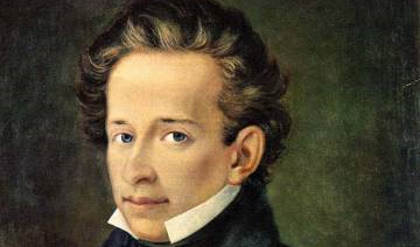
Factoid #8 (Spring 2008)
The Marche is the 3rd region in Italy for numbers of trees - there are around 300 trees for each resident.
Northern bites (Summer 2008)
While the Adriatic boasts some of the finest fresh fish in Italy, one of the region's classic dishes is based on humble dried fish from the cold, grey waters of the North Sea. Stoccafisso all'Anconitana is made with stockfish - wind-dried cod from Norway - potatoes and very slow cooking. As its name suggests, it is best tried in the region's capital at Ancona.
The use of stoccafisso and its cousin baccalà, or salt cod, goes back to early Medieval times in Italy, and it was once one of the most important commodities traded between the Mediterranean and Scandinavia, often in exchange for salt.
Forty years on (Summer 2008)
On 11 August 1968 the Marche's most famous white wine, Verdicchio dei Castelli di Jesi, received official recognition as a "DOC" wine (Denominazione di Origine Controllata - the Italian equivalent of the French Appellation Contrôllée). And to mark the fortieth anniversary a range of events have been organized in a number of the 24 comuni where the wine is made.
Verdicchio-themed festivals worth visiting include Verdicchio in Festa at Montecarotto from 2 to 6 July, the Festa del Verdicchio at Staffolo from 21 to 24 August, and the Sagra dell'Uva at Cupramontana on the first weekend of October.
Racing pulses (Winter 2008/09)
The small, dark lentils grown in the southern uplands on the Marche-Umbria border are considered to be some of the finest in the world, and no New Year's Eve dinner is complete in the Marche without a dish of lenticchie from Colfiorito or Castelluccio, as lentils are said to auger prosperity for the coming year.
The region is also noted for its cultivation of cicerchia - now a little-known pulse that was once raised as an "insurance" against drought and famine when all other crops might fail, thanks to its ability to grow in poor conditions.
The seeds of Lathyrus sativus are about the same size as peas but knobbly and buff-coloured. Cicerchia has been officialy recognised as one of the region's prodotti agroalimentari tradizionali and the humble legume now has an annual festival in its honour at Serra de' Conti in Ancona province.
They need to be soaked for at least 8 hours before cooking, changing the water 2 or 3 times, then boiled in plenty of unsalted water for around 40 minutes. Once cooked they should be left in the water and only drained when ready to be used - this avoids hardening as they cool. They are best used in hearty soups but also make a good substitute in most recipes for ordinary beans.
And then there was Raphael (Spring 2009)
The great High Renaissance painter Raphael - perhaps the region's most famous son - is being celebrated with a major exhibition of his early masterpieces in his native town of Urbino between 4 April and 12 July, 2009.
The show, Raffaello e Urbino takes place in the Palazzo Ducale and features 20 paintings and 19 drawings alongside works by his father, Giovanni Santi, and other artists that were his contemporaries. Raffaello Sanzio was born in Urbino in 1483 and died in 1520 at the age of only 37.
By Genga! (Winter 2009/10)
The photo below shows the remarkable octagonal church built by the celebrated 18thC Roman architect Giuseppe Valadier high up on the rock face of the Frasassi Gorge - not to be missed if you're visiting the nearby Frasassi caves.
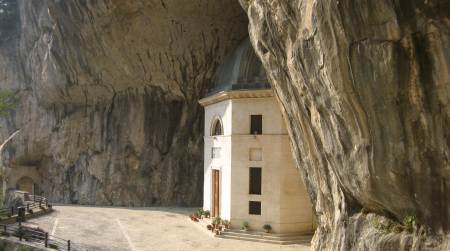
If you happen to be nearby over Christmas try to see the "living crib" where 300 locals dress up to play the traditional roles in the Christmas story on 26 December and 3 January; it is claimed to be the largest by extension in the world.
Say cheese (Spring 2010)
If you're in the Marche at Eastertime look out for the fragrant, yellow loaves of Crescia di Pasqua al formaggio, a rich bread with eggs and cheese baked in homes across the region only at this time of year. Traditionally it's eaten for breakfast on Easter Sunday morning with eggs blest by the priest and the first salame now ready from the January pig killing.
Each family has its own slightly different recipe, some with more or less cheese, some with just grated Parmesan, others with some grated mature pecorino ewe's milk cheese, some with small cubes of young pecorino. But all feature eggs, flour, yeast, and plenty of good olive oil. In the days after Easter enthusiasm for crescia begins to wane and leftovers begin to go stale - the best way to perk them up is to serve slices spread with tuna and mayonnaise.
An unholy anniversary (Summer 2010)
The statuesque hill town of Castelfidardo celebrates the 150th anniversary this year of a celebrated battle in the fight for the Unification of Italy, when the Piemontese army routed the "crusaders" of the Papal forces. The Battaglia di Castelfidardo took place on 18 September 1860 and saw some 150 troops killed from both sides; it was to be one of the last battles ever to be fought by the Papal States.
The next Florida? (Autumn 2010)
The Marche is one of the ten best places in the world to retire to according to AARP Magazine, the US pensioners' publication with over 35 million subscribers. The article describes the region as "the next Umbria", and goes on to praise it as "a lovely land of vineyards, snow-capped mountains, and splendid beaches". Other countries featured in the top ten include Argentina and Belize.
Factoid #20 (Spring 2011)
One of the decisive battles in the second Punic War took place on the banks of the Metauro river in the northern Marche in 207 BCE. The Battle of the Metaurus saw the Romans roundly defeat Hasdrubal - the brother of the renowned Hannibal - and his 30,000 Carthaginian troops, most of whom lost their lives in the battle.
Factoid #21 (Summer 2011)
The fabled medieval Holy Roman Emperor Frederick II was born in a tent on 26 December 1194 at Jesi in Ancona province. Frederick, known as Stupor Mundi for his stirring achievements, later he called it his special town, the very name seeming to recall that of Jesus.
The peach boys (Summer 2011)
Some of Italy's finest peaches are grown in the Marche around the small town of Montelabbate near Pesaro. The mild climate and well-drained soil of the Foglia valley are ideal for growing the fruit, noted for its sweet flesh and dark plush skin. So good is it that the town holds an annual Sagra delle Pesche, set to take place this year on Sunday 17 July.
Meanwhile down south at Porto San Giorgio on the coast, Sunday 17 July also sees the Festa del mare, a celebration of all things fishy, and featuring a giant "frying pan". The Padella gigante dell'Adriatico is six metres in diameter, holds some 1,000 litres of cooking oil and is used to fry roughly 1,000 kilos of baby squid and sardines in around three hours.
Introduction (Spring 2012)
After record-breaking snows this winter - almost two metres around Urbino - almond and hawthorn blossoms herald the arrival of spring. The priest has passed to bless both the house and the eggs to be eaten on Easter morning. The circle turns, and once again it's time for the spring issue of the quarterly Marche Voyager newsletter. Buona Pasqua!
Jump to it! (Spring 2012)
The first Sunday after Easter sees an unusual race at Fermignano near Urbino when the different quarters battle it out running with frogs on wheelbarrows. The Palio della Rana also features plenty of medieval costumes, flag-waving and abundant refreshments. Well worth hopping along to...
Factoid #28 (Spring 2013)
Between 1796 and 1806 Napoleon Bonaparte carried away over 500 works of art from Italy of which only around half were returned after the emperor's defeat at Waterloo. Many fine paintings that once adorned Marche churches and palaces now have to be admired at the Louvre in Paris or the Brera gallery in Milan.
Fennel with everything (Summer 2013)
Wild fennel - finocchio selvatico - is one of the most distinctive wild herbs used in Marche cooking and summer is when you'll find it at its best. The fine, feathery leaves are used with broad beans (fava beans) and with roast, stuffed rabbit (coniglio in porchetta) while the dried stems and seeds are used, amongst other things, to flavour olives in brine. Its aromatic anise flavour is also essential when cooking lumachini di mare (sea snails, or winkles) and ordinary land snails, both common dishes in the northern stretches of the region. And the chicest of chefs now use freshly shaken pollen from the young yellow flowers.
Worth a detour (Autumn 2013)
There is little left of the 9th century Abbey of Rambona near Pollenza in Macerata province, but what remains is well worth hunting out. Decorated with an assortment of ancient carved capitals from the nearby Roman town of Pollentia, the crypt (see below) is one of the finest of its kind in the Marche.
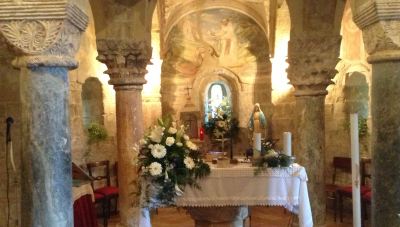
After the Romans (Autumn 2014)
The small Romanesque church at San Vittore delle Chiuse in the Frasassi Gorge was built in the 12thC on chastely simple lines and is one of the prettiest of its kind in the Marche - well worth hunting out if you're visiting the nearby Frasassi caves.
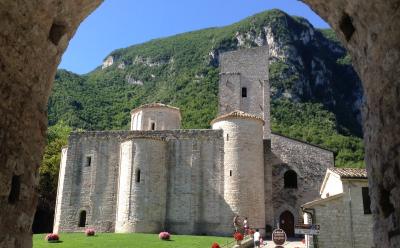
Hats off to Montappone (Spring 2015)
The little town of Montappone in Fermo province has fewer than 2,000 inhabitants but boasts some 40 hat manufacturers and even a "hat museum". Federico Fellini's signature headgear came from here.
Those Guardian angels (Spring 2016)
The British newspaper The Guardian featured the Marche in its New Year's holiday "hotlist" for 2016. It listed some 40 places around the world as the top destinations for the coming year, and described the region as "Beaches and art without the crowds".
Brotherly frescoes (Summer 2016)
This year marks the 600th anniversary of the completion of the jewel-like frescoes in the Oratory of San Giovanni Battista in Urbino. Celebrating the life of St John the Baptist, these masterpieces of the International Gothic style of the 15th century were painted by the Marche brothers Lorenzo and Jacopo Salimbeni in 1416.
The small church in the heart of the town is open daily, but is closed for lunch from 1pm to 3pm and on Sunday afternoons.
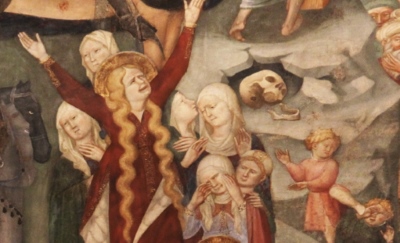
Twenty glorious years! (Spring 2017)
April marks the 20th anniversary of Marche Voyager. The site went online on 7 April 1997 when there were barely a million websites in the whole world, and Altavista ruled Internet search.
Since then some 5 million visitors (unique hosts) have looked at around 20 million pages, and though we're biased, we think the site is still the best English-language web resource on Italy's Marche region. Here's to the next 20 years!
Cherry time! (Summer 2017)
Now is the time to pick visciole, the wild sour cherries that grow in the northern Marche and are used to make a lip-smackingly delicious liqueur called visner or vino di visciole. This sweet digestivo is made by macerating the crushed dark cherries in red wine with sugar, lemon peel and either cinnamon or cloves. Some also fortify the mix with rum.
For the very best you really need to try the home-made brews made using secret family recipes, but a number of local producers now make excellent commercial versions for sale in enoteche, or wine shops, across the region.
Paint magic (Summer 2018)
You are promised one of the Marche's most striking works of art when you visit the handsome Basilica of San Nicola at Tolentino: marvel at the grandiose Giottoesque frescoes that cover the walls and ceiling of the gothic Cappellone di San Nicola - vivid masterpieces from the 14th century.

detail from the frescoes
Infobyte #50 (Autumn 2018)
St. Francis first visited the Marche region from neighbouring Assisi in 1208; by 1282 in the Ancona area alone there were some 85 friaries with around 1,500 Franciscans.
This newsletter is only sent to people who have personally subscribed to it through the Marche Voyager web site. If you do not wish to receive further issues please unsubscribe here. Alternatively, please e-mail us
giving the e-mail address to which this newsletter was sent and "unsubscribe" in the message subject. You are subscribed at [EMAIL]
.
If you have problems reading this HTML newsletter you can see it on the web
here.
We appreciate feedback - any comments, suggestions, criticism or praise gladly received; E-mail us here.
© le-marche.com
| 